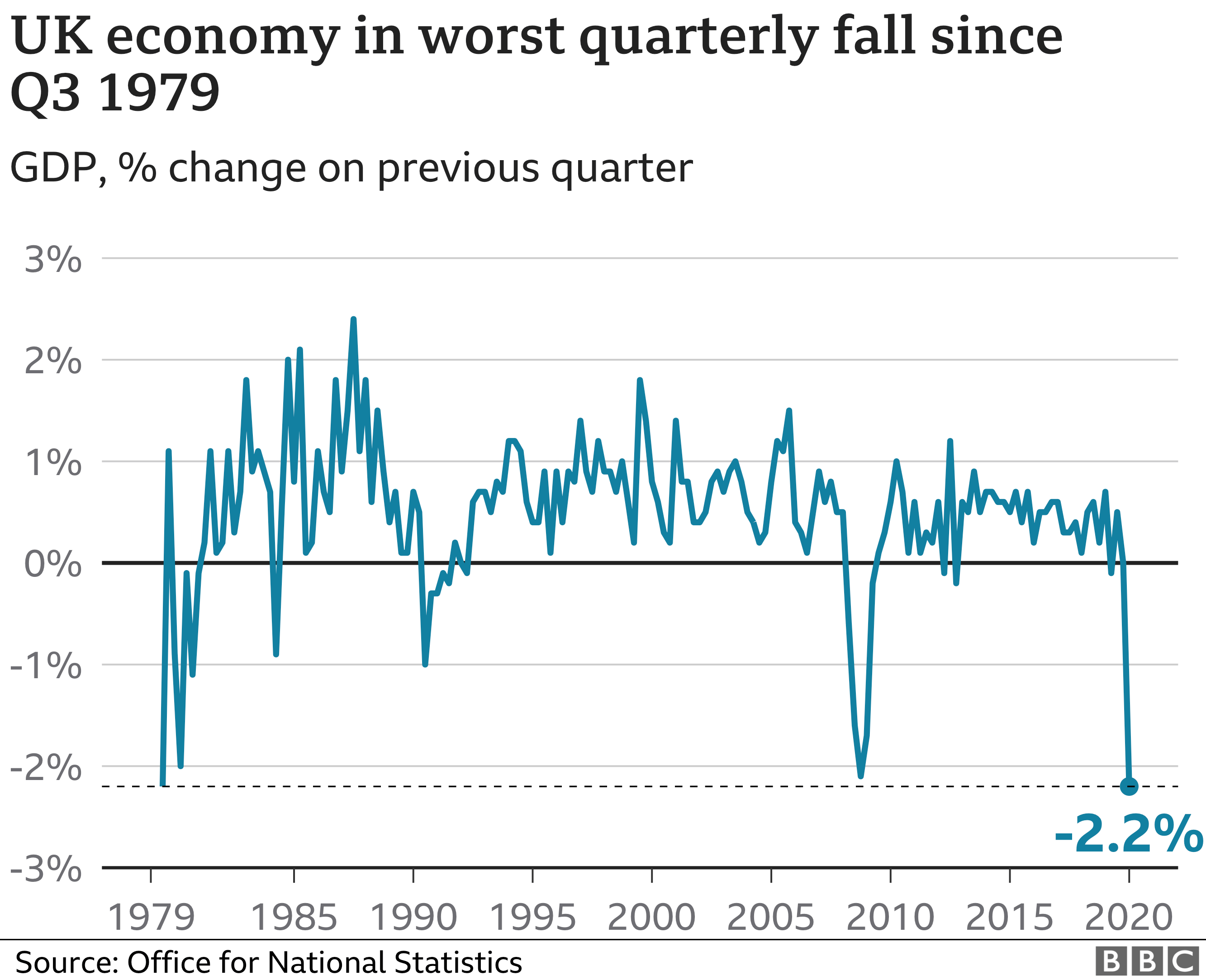The UK economy shrank more than first thought between January and March, contracting 2.2% in the joint largest fall since 1979, official figures show.
The Office for National Statistics (ONS) revised down its previous estimate of a 2% contraction, with all the main economic sectors dropping.
There was a significant economic impact in March, as the coronavirus pandemic began to have an effect.
The data comes as the prime minister set out a post-lockdown recovery plan.
Boris Johnson said in a speech in Dudley, in the West Midlands, that there would be investment in infrastructure and schools.

Jonathan Athow, deputy national statistician at the ONS, said: “Our more detailed picture of the economy in the first quarter showed GDP shrank a little more than first estimated.
“Information from government showed health activities declined more than we previously showed.
“All main sectors of the economy shrank significantly in March as the effects of the pandemic hit.”
The first-quarter contraction is now the joint biggest drop since the July-to-September period in 1979
Mr Athow said: “The sharp fall in consumer spending at the end of March led to a notable increase in households’ savings.” The new data showed that GDP contracted by 6.9% in March.
The first-quarter figures show that the services sector – which accounts for about three-quarters of UK GDP – shrank by a record 2.3%.
The ONS said production output fell by a revised 1.5% in the three months, driven by declines in manufacturing as factories temporarily shut down, while there was a fall in construction output of 1.7%.
The coronavirus lockdown only came into force on 23 March, so figures for the second quarter of the year will show the full hit on the economy.
Recent ONS monthly figures showed the economy plummeted by 20.4% in April – the largest drop in a single month since records began.
That contraction was three times greater than the decline seen during the whole of the 2008 to 2009 economic downturn.

Off the scale
It says something that the first quarter of the year was the worst for the economy in 41 years – and yet it was still barely a tenth the size of the contraction in activity in just one month – last April.
The figures put the government’s “build build build” announcement in perspective. The £5bn infrastructure spending being “brought forward” is not new money in any case. It was set aside in the pre-election manifesto at a time when the economy looked very different.
Compare it, say, to the £69bn it’s estimated that small businesses will lose in the pandemic because they’ve had to stop trading (according to research by small business insurers Simply Business). Or compare it to total public spending of more than £1,000bn, and it’s less than 0.5%.
Against the size of the economy based on the latest GDP numbers, the mooted infrastructure spend is more like 0.25%. The government’s going to have to spend a lot more than that to stimulate a recovery from a slump on this scale.

Samuel Tombs, chief UK economist at Pantheon Macroeconomics, said the latest figures could be summed up in one line: “The biggest contraction for 40 years, even though Q1 contained just nine lockdown days.”
The data “was just the prelude”, with worse to come, he added.
However, while economists are braced for a dire set of second-quarter figures, Howard Archer, at the EY Item Club, believes April’s sharp contraction is likely to have been the low point.
He predicted the economy would “return to clear growth in the third quarter with GDP expanding close to 10% quarter-on-quarter” as lockdown restrictions are eased further.
‘Radical reforms’
In a speech on Tuesday, Mr Johnson promised an “infrastructure revolution”, arguing the government needed to “work fast” to support jobs whilst also seeking to “level up” the economy so that all parts of the country can benefit.
He said the government would introduce “the most radical reforms of our planning system since the end of the Second World War” to speed up building and infrastructure projects where, he argued, the UK compares unfavourably with other European countries.
As part of what he called a “new deal”, the prime minister set out plans to accelerate £5bn of spending on infrastructure projects.
Meanwhile, separate ONS data on the nation’s finances showed that Britain’s current account deficit widened by more than expected in the first quarter.
The balance of payments deficit – the difference between the value of the goods and services that a country imports and the goods and services it exports – rose to £21.1bn, or 3.8% of GDP.
This means the UK is reliant on inflows of cash from abroad and leaves the pound vulnerable, according to Mr Tombs.
“Sterling almost certainly would depreciate sharply again if a major second wave of Covid-19 emerges or if the UK and EU fail to either sign a trade deal or to extend the transition period before the end of this year,” he said.
— BBC



